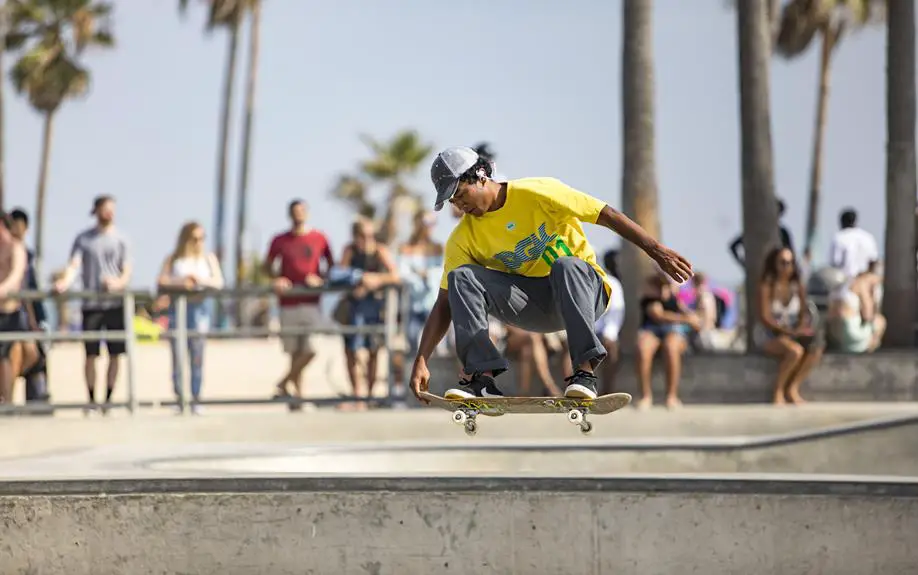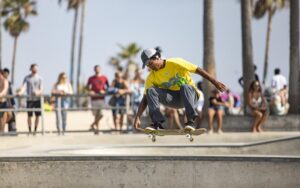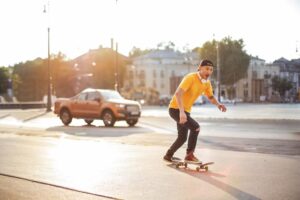Do you ever wonder what muscles really get a workout when you hop on a skateboard?
Get ready to be amazed because skateboarding isn’t just about cool tricks and stunts—it’s also an incredible way to work your entire body.
In this article, we’ll dive into the world of skateboarding and explore which muscle groups are engaged during this exhilarating activity.
By understanding how skateboarding impacts your fitness, you can maximize its benefits and improve your performance on the board.
So, let’s start and discover the amazing workout skateboarding offers!
What Muscles Does Skateboarding Work
When you skateboard, several muscle groups in your body are put to work, including the following.
Core Muscles
When you skateboard, your core muscles are crucial in maintaining balance and stability. Your abdominal muscles, including the rectus abdominis and transverse abdominis, work to keep your body aligned and prevent excessive twisting or bending.
The obliques on the sides of your abdomen help with rotational movements and maintaining control during turns.
Additionally, the lower back muscles, such as the erector spinae, provide support and help you maintain an upright posture while riding.
Strong core muscles are essential for skateboarding and can contribute to improved performance and injury prevention.
Abdominal muscles
Do you know which abdominal muscles are primarily engaged when skateboarding? Skateboarding requires a strong core to maintain balance and stability while performing tricks and maneuvers.
The abdominal muscles that are primarily activated during skateboarding include:
- Rectus abdominis: This muscle runs vertically down the front of your abdomen and helps flex the spine and stabilize the pelvis.
- Transverse abdominis: Located deep within your abdomen, this muscle is crucial in maintaining core stability and protecting the spine.
- Obliques: The external and internal obliques are responsible for trunk rotation and lateral flexion, helping you maintain control while skateboarding.
Obliques
To strengthen your core while skateboarding, engage your obliques by performing twists and turns. Your obliques are the muscles located on the sides of your abdomen, running from your ribs to your hips. When you twist your body while skateboarding, these muscles are activated, helping you maintain balance and control.
Regularly working your obliques through skateboarding can develop a strong and stable core, which is essential for overall body strength and coordination.
Lower back muscles
Engage your lower back muscles while skateboarding to improve your core strength and stability.
Skateboarding requires balance and control, which heavily relies on the muscles in your lower back. By activating these muscles, you can enhance your ability to maintain balance and perform tricks effectively.
Strong lower back muscles also help to protect your spine and prevent injuries. So, don’t forget to include exercises that target your lower back in your skateboarding training routine.
Leg Muscles
When you skateboard, your leg muscles are crucial in maintaining balance, stability, and generating power for various movements. The following make the leg muscles.
Quadriceps (Quads)
Skateboarding is a great way to engage your quadriceps and strengthen your leg muscles. Here’s how it works:
- When you push off the ground to gain momentum, your quadriceps are activated to extend your knee.
- As you perform tricks and maneuvers, your quadriceps provide stability and control.
- The constant bending and straightening of your knees during skateboarding help to build strength and endurance in your quadriceps.
Skateboarding is a fun and effective way to target and strengthen your quadriceps, leading to stronger and more toned leg muscles.
Hamstrings
Feel the burn in your hamstrings as skateboarding requires you to constantly flex and extend your legs. Your hamstrings at the back of your thighs play a crucial role in stabilizing your body and generating power during skateboarding movements.
These muscles work in conjunction with your quadriceps to provide balance and control while performing tricks and maneuvers. Strengthening your hamstrings through skateboarding can improve your leg stability, agility, and overall performance on the board.
Gluteus Maximus
You’ll be amazed at how the gluteus maximus muscles, also known as your glutes, work in conjunction with your leg muscles to power your skateboarding movements. The glutes play a crucial role in providing stability and power during tricks and maneuvers.
Here’s how they contribute to your skateboarding performance:
- Gluteus maximus helps in generating power for ollies and jumps.
- It stabilizes your body during landings and maintains balance.
- The glutes also assist in pushing off the ground and propelling your skateboard forward.
These muscles are essential for a strong and controlled skateboarding experience. So, don’t forget to give your glutes some attention in your training routine.
Calf muscles
To maximize your skateboarding performance, it’s important to strengthen and engage your calf muscles. These muscles at the back of your lower leg play a crucial role in skateboarding. They help you maintain balance and stability while pushing off and performing tricks.
The calf muscles of the gastrocnemius and soleus work together to provide power and control during skateboarding movements. Regular skateboarding sessions can help tone and strengthen your calf muscles, improving your overall performance on the board.
Lower leg muscles
Skateboarding engages multiple lower leg muscles, including the quadriceps, hamstrings, and calf muscles, to provide stability and power during various skateboarding movements. These leg muscles are crucial in maintaining balance, generating speed, and executing tricks.
The quadriceps, located at the front of the thigh, help extend the knee and provide power for jumps.
The hamstrings, at the back of the thigh, aid in bending the knee and absorbing impact.
Lastly, the calf muscles assist in controlling the ankle and providing stability.
Upper Body Muscles
When it comes to skateboarding, your upper body muscles play a crucial role in maintaining balance and executing tricks. The following upper body muscles are involved when skateboarding.
Deltoids
Your deltoids, or shoulder muscles, play an important role in skateboarding as they help stabilize your upper body during tricks and maneuvers. When you’re performing ollies, kickflips, and grabs, your deltoids provide the necessary strength and control.
They also assist in maintaining balance and coordination while executing complex movements. Strong deltoids are crucial for maintaining proper posture and preventing injuries.
Regular skateboarding can help develop and strengthen these muscles, allowing you to improve your performance and enjoy the sport to the fullest.
Triceps
Developing strong triceps is essential for improving your skateboarding performance and preventing injuries. Your triceps on the back of your upper arm play a crucial role in stabilizing your body while skateboarding. When you push off the ground or perform tricks, your triceps are engaged to provide power and stability.
Strengthening your triceps through exercises like tricep dips or push-ups can help you maintain better control and balance on your skateboard. So, don’t forget to give your triceps the attention they deserve to enhance your skateboarding skills.
Biceps
Strengthening your biceps is crucial for improving skateboarding performance and maintaining upper body stability. When you skate, your biceps play a significant role in providing strength and control. Here’s why:
- Biceps help you maintain balance and stability while performing tricks.
- They assist in generating power for pushing and propelling yourself on the skateboard.
- Biceps are engaged when performing grabs and holding onto the skateboard during aerial maneuvers.
Skateboarding Styles and Muscle Emphasis
Now let’s delve into the different styles of skateboarding and how they emphasize different muscle groups.
Street skateboarding
Typically, street skateboarding requires you to engage your leg muscles more frequently for tricks and maneuvers. The constant pushing off the ground and jumping onto obstacles significantly emphasizes your lower body strength.
Moreover, street skateboarding also targets your core muscles, which are crucial in maintaining balance and stability while performing tricks. Here are some key points to consider:
- Leg Muscles: Street skateboarding involves a lot of leg movements, including pushing off the ground, jumping, and landing. This puts stress on your quadriceps, hamstrings, calves, and glutes.
- Core Muscles: Your core muscles, including the abdominal muscles, obliques, and lower back muscles, are engaged to maintain balance and stability during tricks and maneuvers.
- Upper Body: Though not as heavily emphasized as the legs and core, street skateboarding also works your upper body muscles, including the shoulders, arms, and chest, as they assist in maintaining balance and performing certain tricks.
Vert skateboarding
To optimize your performance in vert skateboarding, focus on building strong leg muscles and maintaining proper form. Vert skateboarding is characterized by high-speed maneuvers and aerial tricks performed on halfpipes and ramps.
This skateboarding style significantly emphasizes leg power, as you need to generate explosive force to propel yourself off the ramp and into the air. Additionally, core strength is crucial in maintaining stability and balance during aerial maneuvers.
Strengthening your core muscles, including your abdominal and lower back muscles, can greatly improve your control and stability while performing tricks on the vert ramp. Incorporating exercises such as squats, lunges, and planks into your training routine can help you develop the necessary leg and core strength for vert skateboarding.
Park skateboarding
Have you ever wondered which muscles are emphasized in park skateboarding?
Park skateboarding, also known as street skateboarding, is a style of skateboarding that involves tricks and maneuvers performed in skate parks or urban environments. This style of skateboarding places a significant emphasis on the upper body muscles.
Here are the key muscles that are worked during park skateboarding:
- Shoulders and arms: When performing tricks such as ollies, kickflips, and grabs, the shoulders and arms are engaged to initiate and control the movements.
- Chest and back: A strong chest and back are essential for stability and balance while performing tricks and maintaining the correct posture.
- Core muscles: The core muscles, including the abdominals and lower back, play a crucial role in maintaining balance and stability during jumps, spins, and landings.
Regularly practicing park skateboarding can build strength and endurance in these upper body muscles, leading to improved overall fitness and performance on the skateboard.
Importance of Muscle Engagement in Skateboarding
Since skateboarding requires the engagement of multiple muscle groups, it is crucial for you to understand the importance of muscle engagement to improve your performance and prevent injuries.
When you engage your muscles properly while skateboarding, you not only enhance your balance and stability, but you also generate more power and control. Let’s take a look at the key muscle groups involved in skateboarding and how they contribute to your overall performance:
| Muscle Group | Function | Importance |
|---|---|---|
| Core | Provides stability and balance | Essential for maintaining control and executing tricks effectively |
| Leg Muscles | Generate power and provide stability | Crucial for pushing, turning, and absorbing impact |
| Arm and Shoulder Muscles | Assist in balance and control | Aid in maintaining stability and executing maneuvers |
| Back Muscles | Support the spine and maintain proper posture | Help prevent injuries and enhance overall stability |
Benefits of a Strong Muscular System in Skateboarding
Building a strong muscular system can significantly enhance your performance and prevent injuries while skateboarding. Engaging and strengthening your muscles can offer a range of benefits that contribute to your overall skateboarding experience.
Here are some specific advantages of having a strong muscular system:
- Improved balance and stability: Strong muscles, especially in your legs and core, provide a solid foundation and help you maintain balance while performing tricks and maneuvers.
- Increased power and speed: Muscles generate force, allowing you to execute powerful movements and accelerate quickly on your skateboard.
- Enhanced endurance: Building and conditioning your muscles can improve your stamina, allowing you to skate longer without fatigue.
A strong muscular system improves your skateboarding performance and reduces the risk of muscle strains and other injuries. So, make sure to incorporate strength training exercises into your skateboarding routine to reap these benefits.
Techniques to Strengthen Muscles for Skateboarding
To strengthen your muscles for skateboarding, incorporating off-skateboard exercises and stretching routines into your training regimen can be highly beneficial.
Off-skateboard exercises
You can incorporate off-skateboard exercises into your routine to strengthen the muscles necessary for skateboarding. These exercises are a great way to complement your skateboarding sessions and improve your overall performance.
Here are some off-skateboard exercises that can be included in your workout plan:
- Squats: Squats are an excellent exercise for building leg and core strength. They target the quadriceps, hamstrings, and glutes, which are all important muscle groups for skateboarding.
- Planks: Planks are a fantastic exercise for strengthening your core muscles. A strong core is essential for maintaining balance and stability while skateboarding.
- Jumping lunges: Jumping lunges are a dynamic exercise that targets the muscles in your legs, including your quadriceps, hamstrings, and glutes. They help improve power and explosiveness, which are important for performing tricks on a skateboard.
Stretching routines
Get ready to enhance your skateboarding performance by incorporating effective stretching routines that strengthen your muscles. Stretching before and after skateboarding is crucial for preventing injuries and improving flexibility.
Start with dynamic stretches like leg swings and arm circles to warm up your muscles and increase blood flow. These stretches help prepare your body for the physical demands of skateboarding.
After your skate session, focus on static stretches to cool down and lengthen the muscles. Perform stretches for your calves, quadriceps, hamstrings, hip flexors, and glutes to target the muscles used in skateboarding. Remember to hold each stretch for at least 30 seconds and avoid bouncing.
Incorporating these stretching routines into your skateboarding routine will keep you injury-free and improve your overall performance on the board.
Proper Skateboarding Form for Muscle Engagement
During skateboarding, maintaining proper form is crucial for effectively engaging your muscles. Following the correct techniques can maximize your muscle engagement and enhance your overall performance. Here are some key elements of proper skateboarding form for muscle engagement:
- Stance: Position your feet shoulder-width apart and place your front foot slightly angled towards the nose of the skateboard while your back foot is perpendicular to the board. This stance allows for better control and stability during maneuvers.
- Balance: Keep your body centered over the skateboard, distributing your weight evenly between your front and back foot. This helps engage your core muscles and promotes better balance while riding.
- Posture: Maintain a relaxed yet upright posture with your knees slightly bent. This position allows for greater flexibility and helps activate your leg muscles, especially the quadriceps and calves.
Nutrition and Diet Tips for Skateboarders
To optimize your performance and support your muscles while skateboarding, fueling your body with the right nutrients is crucial.
Fueling your muscles
Ensure you’re properly fueling your muscles with the right nutrition and diet tips for skateboarders. Skateboarding is a physically demanding activity that requires energy and stamina. To perform at your best, consider the following tips:
- Stay hydrated: Drinking enough water is crucial for maintaining optimal performance and preventing muscle cramps.
- Eat a balanced diet: Fuel your body with various nutrients, including carbohydrates, proteins, and healthy fats. Carbohydrates provide the energy needed for intense skateboarding sessions, while proteins help repair and build muscle tissue.
- Snack smart: Choose nutritious snacks like fruits, nuts, and yogurt to keep your energy levels stable throughout the day.
Hydration and recovery
Hydration is crucial for maintaining energy levels and preventing dehydration, which can negatively impact your balance, focus, and overall performance. Ensure you drink plenty of water before, during, and after your skateboarding sessions.
It’s also important to replenish your electrolytes, especially if you’re sweating heavily. Sports drinks or coconut water can be good options for electrolyte replacement.
Recovery is equally important to prevent muscle soreness and promote muscle repair. After skateboarding, cool down with some light stretching and consider incorporating post-workout nutrition, such as a protein-rich snack or meal, to support muscle recovery.
Adequate rest and sleep are also essential for recovery, so make sure to prioritize rest days and get enough sleep each night.
What muscles do skateboarding work | Wrapping Up
As you wrap up your exploration of the muscles involved in skateboarding, it’s important to understand this sport’s overall impact on your fitness level. Skateboarding engages multiple muscle groups, resulting in a full-body workout that can improve your strength, endurance, and balance.
Here are the key muscles that skateboarding works:
- Core muscles: Skateboarding requires a strong core to maintain stability and balance while performing tricks and maneuvers.
- Leg muscles: Your quadriceps, hamstrings, and calf muscles are heavily engaged as you push off the ground, perform jumps, and land tricks.
- Glutes and hip muscles: These muscles contribute to your stability and control while riding the skateboard.
Can Skateboarding Be a Career? Is it Possible to Make a Living on Your Board?





